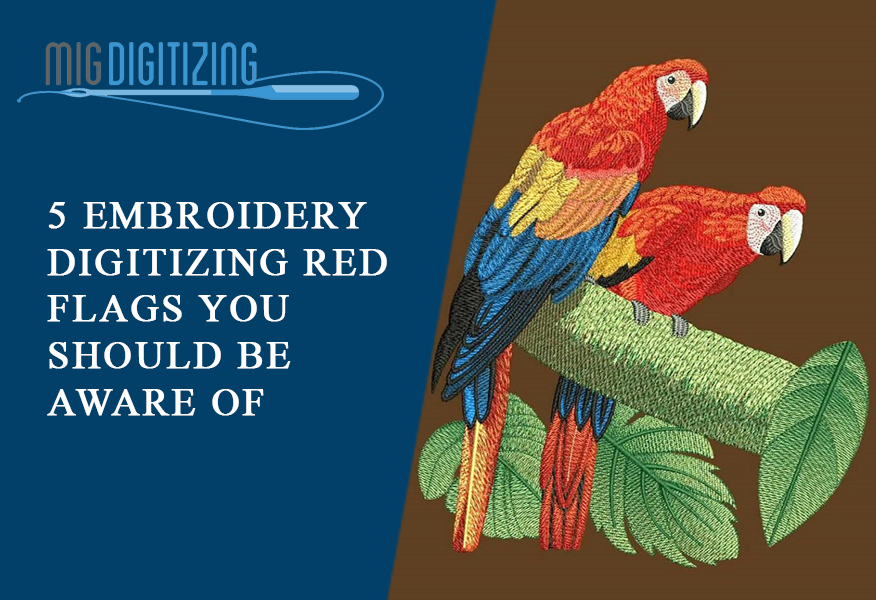
Digitizing for embroidery is a tough job to do, especially if you are a newbie. A great digitizing design is the combination of a couple of different processes that involve needlework, stitching, and much more. Today, we will talk about how you can achieve brilliant results by avoiding the most common embroidery red flags that can ruin your artwork. Let’s get started.
As a beginner, the embroidery process will be a test for you. That .dst files that you have might not always become the needlework that you wish to get if you are not aware of the results. Plus, it might also cause a negative layout in the stitches and will trigger the material to tighten.
As an embroidery digitizer, it is your job to fine-tune the embroidery designs that suit your project’s requirements and have a straight affect on the needlework. It is better to look within the production phase along with errors that can alter production.
Here are our suggestions on some of the five most common embroidery digitizing red flags you should stay away from.
-
Ignoring The Details Before Digitizing
Details are necessary. In fact, it is all about the details. Lack of preparation beforehand increases the chances of embroidery artwork that might need trims and modifications for push/pull compensation.
It will be a waste of your time if you are ignoring the details. To avoid any mishappening, it is better to create a list of products that you will be using throughout the embroidery process.
It should have every little detail from the stitch types to thickness. When you have these details
in hand, it would be much easier for you to finish the embroidery work.
-
Not Measuring The Stitch Density
The thickness of a stitch is the stitch variety within a square centimeter. If you have not established properly, it will change your entire project for embroidery. As an embroidery digitizer, you really need to take care of the measurements. A large thickness on a gentle fabric will not show up and will fall down into the fabric too.
To make beautiful designs, you need to apply a certain amount of, it is important for you to choose the right stitch density when working with different stitch types. And do not take fabric easy. It should be on the top of your when it comes to stitching density ratio. As a rule of thumb, the high thickness is ideal for larger clothing materials while the low stitch thickness is appropriate for light fabric material.
-
Ignoring The Fabric
Along with your artwork, it is also important to examine the material that you will use for the digitizing design. It is important to give concentration to the fabric along with checking the appearance. There are few questions you need to consider before taking any action. Is it linen or jeans, or a woven towel twill, or maybe a weaved textile that has an elastic with an adaptable structure? To keep yourself away from these mistakes in the embroidery digitizing process, make sure to go with the right combination with keeping all these aspects of a fabric.
The accurate embroidery process remains on the top if you are working in an embroidery digitizing company. Making errors while digitizing can put you in trouble and mess up the needlework. Avoiding these mistakes will let you create perfect needlework that will look excellent on the material.
-
Skipping The Lock Stitches
This is another red flag in the embroidery digitizing process. Lock stitches are usually the last element you need to watch in your embroidery artwork. Yet, many often forget to take it into consideration. However, there are a lot of fabrics that require lock stitches in order to maintain the stitches so that they do not reverse in the area.
-
Determining The Wrong Stitch Length And Width
The stitch length and width play a crucial role in creating a particular stitch type. Using inappropriate stitch length and width can ruin the result of your embroidery artwork.
This can create a problem when you are dealing with letters in which the stitch size plays an important role. An incorrect size value can make the text appear inadequate. Inaccurate size can trigger the stitches and will look unappealing and limited as well. Plus, it will affect the coverage of the design.
Therefore, you need to set ideal size values for your work. A bad stitch length and breadth of the stitches are able to come with the padding stitches as well as the text size.
Conclusion
These are the five most common embroidery digitizing red flags you should be aware of during your process. Whether you have just started out or had a solid knowledge of the digitizing field, make sure you keep yourself away from these blunders. If you still have any questions about the topic or anything related to custom embroidery designs, feel free to reach out to us at Migdigitizing. We will be happy to assist you.



